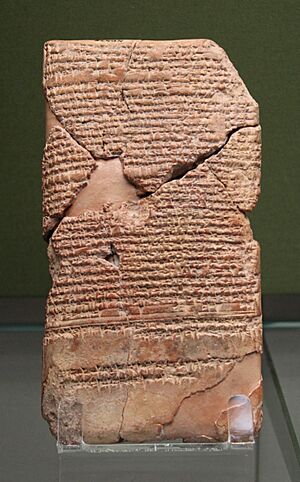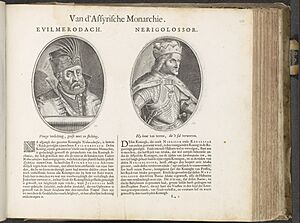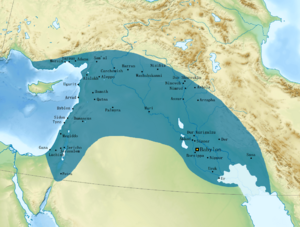Amel-Marduk facts for kids
Quick facts for kids Amel-Marduk |
|
|---|---|

The tablet recording the plea by the jailed prince Nabu-shum-ukin, probably the future Amel-Marduk
|
|
| King of the Neo-Babylonian Empire | |
| Reign | 7 October 562 BC – August 560 BC |
| Predecessor | Nebuchadnezzar II |
| Successor | Neriglissar |
| Died | August 560 BC Babylon |
| Issue | Indû |
| Akkadian | Amēl-Marduk |
| Dynasty | Chaldean dynasty |
| Father | Nebuchadnezzar II |
| Mother | Amytis of Babylon (?) |
Amel-Marduk (Babylonian cuneiform: ![]() Amēl-Marduk, meaning "man of Marduk"), also known as Awil-Marduk or Evil-Merodach Hebrew: אֱוִיל מְרֹדַךְ, romanized: əwil məroḏaḵ in the Hebrew Bible, was the third king of the Neo-Babylonian Empire. He ruled from 562 BCE until he was overthrown and killed in 560 BCE. He took over from his father, Nebuchadnezzar II (r.605–562 BCE).
Amēl-Marduk, meaning "man of Marduk"), also known as Awil-Marduk or Evil-Merodach Hebrew: אֱוִיל מְרֹדַךְ, romanized: əwil məroḏaḵ in the Hebrew Bible, was the third king of the Neo-Babylonian Empire. He ruled from 562 BCE until he was overthrown and killed in 560 BCE. He took over from his father, Nebuchadnezzar II (r.605–562 BCE).
We don't know much about Amel-Marduk's time as king. This is because few ancient writings from his reign have survived. Amel-Marduk's first name was Nabu-shum-ukin. He wasn't his father's oldest son, even though he was chosen to be the next king. It's a bit of a mystery why his father chose him, especially since they seemed to have had disagreements. Amel-Marduk was even put in prison at one point. He might have been jailed with Jeconiah, the captured king of Judah. After he was released, Nabu-shum-ukin changed his name to Amel-Marduk. This was likely to honor the god Marduk, to whom he had prayed.
Amel-Marduk is mostly remembered for setting Jeconiah free after 37 years in prison. He also did some building work in Babylon and possibly other places. However, we don't know how much he built. People in Babylon seemed to dislike his rule. Later Babylonian writings describe him as not being a good leader. In 560 BCE, his brother-in-law Neriglissar overthrew and killed him. Neriglissar then became the new king.
Becoming King
Amel-Marduk became king after his father, Nebuchadnezzar II. It seems that becoming king after Nebuchadnezzar was not easy. The last years of Nebuchadnezzar's rule might have been politically unstable. In one of his late writings, Nebuchadnezzar said the gods chose him to be king before he was born. Kings usually stressed their divine right to rule only if they were new rulers or if there were problems with their chosen successor. Since Nebuchadnezzar had been king for decades, the second reason seems more likely.
Amel-Marduk was chosen as the next king during his father's reign. He is mentioned as the crown prince in 566 BCE. Amel-Marduk was not Nebuchadnezzar's oldest son. Another son, Marduk-nadin-ahi, was an adult in 602/601 BCE. He was in charge of his own lands. Since Amel-Marduk is mentioned much later, Marduk-nadin-ahi was probably the oldest son. It is unclear why Amel-Marduk was chosen, especially since Marduk-nadin-ahi was still alive in 563 BCE.
There is also evidence of arguments between Nebuchadnezzar and Amel-Marduk. This makes Amel-Marduk's selection as heir seem even stranger. One ancient text mentions a conspiracy involving both Nebuchadnezzar and Amel-Marduk. One of them was accused of bad behavior towards temples and people.
Concerning [Nebu]chadnezzar they thought [. . .] his life were not treasured [by them . . . the people of] Babylon to Amēl-Marduk spoke, not [. . .] . . . "concerning the treasure of [the Esagila] and Babylon [. . ."] they mentioned the cities of the great gods [. . .] his heart over son and daughter will not let [. . .] family and tribe are [not . . .] in his heart. All that is full [. . .] his thoughts were not about the well-being of [the Esagila and Babylon . . .], with attentive ears he went to the holy gates [. . .] prayed to the Lord of lords [. . .] he cried bitterly to Marduk, the gods [..w]ent his prayer to [. . .].
This writing talks about accusations of disrespecting holy places and taking advantage of people. These were two main duties of the king of Babylon. The accused person then cried and prayed to Marduk, the main god of Babylon.
Another text from Nebuchadnezzar's later reign includes a prayer from his imprisoned son, Nabu-shum-ukin (![]() Nabû-šum-ukīn). This son said he was jailed because of a plot against him. An ancient Jewish text, the Leviticus Rabbah, says Amel-Marduk was imprisoned by his father. He was jailed along with the captured Judean king Jeconiah. This happened because some Babylonian officials had declared Amel-Marduk king while Nebuchadnezzar was away.
Nabû-šum-ukīn). This son said he was jailed because of a plot against him. An ancient Jewish text, the Leviticus Rabbah, says Amel-Marduk was imprisoned by his father. He was jailed along with the captured Judean king Jeconiah. This happened because some Babylonian officials had declared Amel-Marduk king while Nebuchadnezzar was away.
Historian Irving Finkel suggested in 1999 that Nabu-shum-ukin was the same person as Amel-Marduk. He believed Amel-Marduk changed his name to "man of Marduk" after being released. This was to show respect to the god he had prayed to. Other scholars agree with Finkel's idea. This also helps explain the earlier text about the conspiracy.
It is possible that Nebuchadnezzar thought Amel-Marduk was not a good choice for king. He might have wanted to replace him with another son. Why Amel-Marduk still became king is not clear. Amel-Marduk likely started his royal duties before he officially became king. This would have been during the last weeks or months of his father's life, when Nebuchadnezzar was sick and dying. The last known record from Nebuchadnezzar's reign and the first from Amel-Marduk's reign are dated to the same day, October 7.
Amel-Marduk's Rule

Very few ancient writings from Amel-Marduk's rule have survived. So, we know almost nothing about what he achieved. Even though he was Nebuchadnezzar's rightful successor, Amel-Marduk seemed to face opposition from the start. This is shown by how short his rule was and how later writings describe him negatively.
Berossus, a Babylonian writer from a later time, said that Amel-Marduk "ruled without thinking and did not care about the laws." Another ancient text says he ignored his family. It also claims that officials refused to follow his orders. This text says he only cared about worshiping Marduk. We don't know if this opposition was because of his earlier plot against his father. It could also be due to disagreements among the royal family, since he wasn't the oldest son. Or it might have been because he was a bad king.
We know little about Amel-Marduk's close family, like his wife or children. He had at least one daughter named Indû. Some later writings incorrectly list three sons for Amel-Marduk. However, it seems the author confused his successors with his sons.
One of Amel-Marduk's inscriptions suggests he repaired the Esagila temple in Babylon and the Ezida temple in Borsippa. But there is no clear archaeological proof or other texts to confirm this work. Some bricks and paving stones in Babylon have his name on them. This shows that some building was done in Babylon during his short time as king.
The Bible says that Amel-Marduk freed Jeconiah, the king of Judah. This happened after Jeconiah had been imprisoned in Babylon for 37 years. This is the only clear political act linked to Amel-Marduk in any surviving source. Kings sometimes showed mercy during their crowning ceremonies. This act might have been part of the Babylonian New Year's Festival. But the exact reason for Jeconiah's release is not known.
Some suggest he did it to gain favor with the Jewish people living in Babylonia. Others think Amel-Marduk and Jeconiah might have become friends while in prison. Later Jewish tradition believed the release was a way to undo Nebuchadnezzar's actions, who had destroyed the Kingdom of Judah. However, there is no sign that Amel-Marduk tried to bring Judah back.
Still, Jewish people at the time likely hoped Jeconiah's release was the first step to Judah's return. This is because Amel-Marduk also freed Baalezer, the captured king of Tyre, and put him back on his throne. The release of Jeconiah is told in 2 Kings 25:27–30 and in the Chronicles of Jerahmeel. Both sources call Amel-Marduk "Evil-Merodach." The Chronicles of Jerahmeel describes the event:
In the thirty-seventh year of the exile of Jehoiachin king of Judah, in the year Evil-Merodach became king of Babylon, he released Jehoiachin from prison on the twenty-fifth day of the twelfth month. He spoke kindly to him and gave him a seat of honour higher than those of the other kings who were with him in Babylon.
Amel-Marduk's rule suddenly ended in August 560 BCE. He had been king for barely two years. He was overthrown and killed by Neriglissar, his brother-in-law, who then became king. The last document from Amel-Marduk's reign is from August 7, 560 BCE. Four days later, documents dated to Neriglissar are known. Neriglissar was likely in Babylon when he took the throne. The conflict between Amel-Marduk and Neriglissar was probably a family dispute.
Neriglissar was married to one of Nebuchadnezzar's daughters, possibly Kashshaya. Kashshaya is mentioned earlier in Nebuchadnezzar's reign than Amel-Marduk. This suggests she might have been older than his sons. It's possible that Neriglissar's takeover was due to a conflict between an older, richer part of the royal family (Nebuchadnezzar's daughters) and a younger, less established but more rightful part (Nebuchadnezzar's sons).
Royal Titles
One of Amel-Marduk's inscriptions was found on a pillar of a bridge in Babylon. It lists his titles as: "Amēl-Marduk, king of Babylon, the one who renovates Esagil and Ezida, son of Nebuchadnezzar, king of Babylon."
Since few of Amel-Marduk's inscriptions are known, we don't have more detailed versions of his titles. He might also have used the title 'king of Sumer and Akkad', which other Neo-Babylonian kings used.
See Also
- List of biblical figures identified in extra-biblical sources


